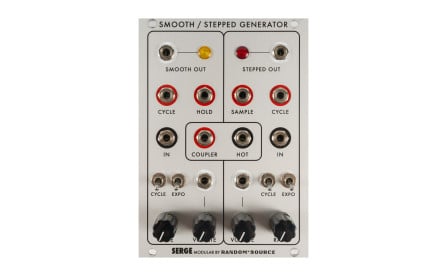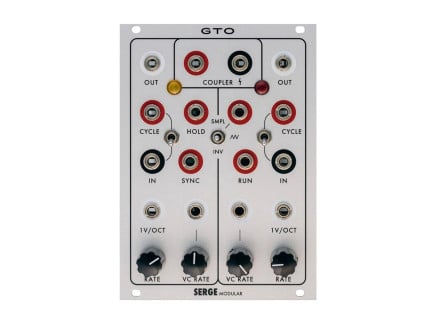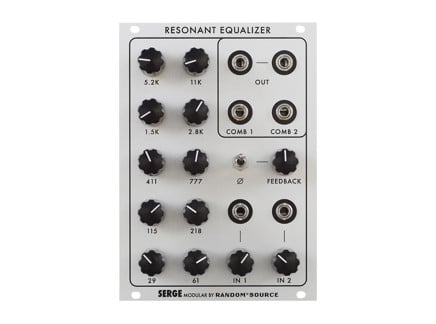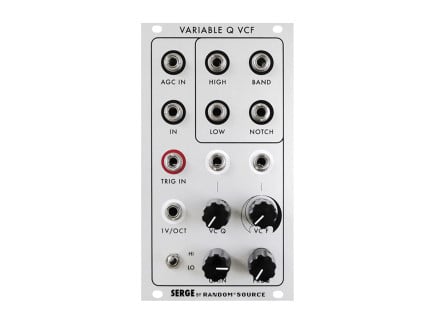Serge Modular is more visible than ever thanks to the work of Random*Source. Not only due to their work in producing authentic Serge panels in the classic 4U format with refined circuits for improved performance but also from adapting the designs to the Eurorack modular synthesizer format. And through their partnership with Serge Tcherepnin himself, Random*Source has become the source for official Serge modules and synthesizers straight from the man who started it all.
Now, the all-new GTO kicks off the latest generation of Serge Modular designs, drawing its functionality from the famous Smooth & Stepped Generator, or SSG for short. With totally overhauled circuitry behind the panel, the GTO expands upon everything that the SSG could do, especially in the realm of audio-rate signals. LFOs, filtering, complex oscillation, random voltage generation, "bit crushing," and more—these are only a few of the things that GTO can do. And because GTO is available first as a Eurorack module, it's instantly ready for incorporation into most modular synthesizers out there.
In this article, we'll go into detail about the GTO's capabilities, supplemented with some crucial background information about the SSG. But describing the SSG is no brief task because it is intentionally an open-ended design, so there's a fair bit of explanation in order. That said if you'd like to get right to the GTO overview, jump down here.
Serge's SSG: the Definitive Patch Programmable Module
While more common synthesizer building blocks such as oscillators or filters can sometimes be used for other purposes, their circuitry and parameters often predispose them to fulfill the role they were designed for. The beauty of Serge's Smooth & Stepped Generator, however, is that it makes lower-level functions accessible to the user—functions that are often abstracted away within more complex designs in other modules.
A number of Serge modules are associated with the idea of "patch programmability," but what does this even mean? In short, a module is patch programmable when its musical purpose at any given time is defined by how it is patched, and thus how it interacts with other modules in a system. Many patch-programmable modules like the SSG can even change behavior when patched into themselves!
Need an example? Nowadays, we take the inclusion of Cycle buttons and switches on modules for granted. But back in the early days of synthesis when the first Serge designs were being produced, you would have to manually patch an End of Cycle gate back into the module's input. Thus, even something as simple as cycling an envelope generator is considered patch programmability, though it has since become so commonplace that it is often just built into a module for convenience.

In my opinion, there's no other module in the Serge catalog that so perfectly encapsulates the patch programming philosophy as much as the SSG. Others like the Variable Q Filter (VCFQ) and the Dual Universal Slope Generator (DSG) come close, but it's the SSG that truly embodies the expression "the whole is greater than the sum of its parts." Although all three of these modules evolved from the consolidation of earlier designs, the SSG matured quickly and it effectively remained unchanged when it appeared in later generations of Serge synthesizers.
As the name suggests, the Smooth & Stepped Generator can produce a variety of... well, smooth and stepped signals, which all depend on how you patch up the SSG. Both generators inside of the SSG consist of a Positive and Negative Slew Limiter chained together, which are functions that appeared independently of each other in the original lineup of Serge modules. These Positive and Negative Slews also serve as the basis of other designs, like the previously mentioned DSG. But it's these simple circuits that make the SSG so very flexible in the hands of an explorative synthesist.
Patching a gate to the Smooth generator's input will result in ramps up or down as the source signal changes, but it will also respond to any stepped signal input. For example, this is useful for applying glide to pitch sequences, with the timing dictated by the Rate control. But by patching audio signals to the input, the Smooth channel can also function as a simple lowpass filter or a surprisingly convincing lowpass gate when modulating rate with an envelope. There's also a Hold input, which upon receiving a high gate signal freezes the Smooth output at its current voltage for track and hold functions.
On the other side of the module is the Stepped generator, which is largely identical to the circuit of the Smooth channel but with one key difference. Rather than having a Hold input, the Sample input activates a pulse generator, perpetually holding the output until the next input is received. As such, the Stepped side is effectively a sample and hold circuit with slew limiting, with its responsiveness determined by the Rate control.

Unlike the Smooth side, however, you will always need something triggering the Sample input—even patching the Stepped generator to cycle won't produce an output until something activates the Sample input. When cycling, the Stepped output can produce staircase waveforms, but any input source will result in anything from stepped random voltages to discretely quantized versions of any waveform.
Part of the SSG's magic is in how its two channels can interact, but even if you're using them independently of each other, the Coupler section always derives signals from their relationship. Beneath the surface, a comparator analyzes the output signals of each channel—if the Stepped side is producing a voltage that's higher than the Smooth side, the Coupler produces a gate signal that lasts until the Smooth produces a higher voltage. The Coupler generally features two outputs: a standard 0-5V pulse output, and a "hot" output that swings from near -12V to + 12V (be careful patching this into mixers and VCAs!).
Random*Source's SSG, both in its 3U Eurorack and 4U formats, already incorporated a number of refinements of the original design to improve its usability in modern patching environments. Courtesy switches for cycling and exponential contours were added, plus additional stability for audio-rate work. But now, with GTO, the concept of the SSG is pushed even further.
Serge GTO: A Hot-Rodded SSG
Now that we've established some of the many things that the SSG can do, we can look at the GTO and see what's new, improved, and overhauled from the original design. Random*Source states in the manual that much of the original circuit was redesigned for "stability, precision, and speed." Even the name of the module, which is an homage to Pontiac's iconic GTO, further drives (pun intended) the point home that it is truly a revved-up version of the original SSG.
One welcome change is the further refinement and extension of the GTO's frequency ranges. The SSG, while flexible enough to work at audio rates, always really shined in the sub-audio range of control voltages. When cycling the GTO, the left side boasts a wide frequency range of 26 seconds up to 20kHz—well over the entire spectrum of human hearing—while the right side caps off at 8kHz on the high end, but extends down to cycles over a minute long. Along with this, the addition of temperature-compensated 1V/Oct inputs on both channels makes them adept as highly stable oscillators with consistent tracking over five or six octaves.
What sort of things can an SSG with improved audio-rate dexterity do? New worlds of audio processing suddenly become available, ranging from improved performance as a filter to pseudo-complex oscillator behaviors. Furthermore, the left side now features a Sync input for those sweet, nasally hard-sync sounds in audible ranges, but is equally handy for resetting LFO cycles when used as a sub-audio modulator.
 An example of waveforms that GTO can produce
An example of waveforms that GTO can produce
But the GTO's biggest differences from the SSG lie with the new Mode switch in the middle of the module, providing three different ways of using the right channel: Smooth, Sample, and INV. As you might guess, Smooth mode allows the right channel to behave just like the left channel but simply tuned to a lower frequency range, as mentioned above. Sample behaves similarly to the classic Stepped generator when fed an external signal, but in cycle mode, it can allow brief cycles to occur before settling into the new voltage. INV mode is the opposite where cycles or external signals are sampled only for a brief moment before resuming.
To extend these modes further, the right side also contains a Run input for alternative behaviors. Regardless of whether the right channel is cycling or processing an external signal, Run behaves just like the Smooth side's hold input—it will freeze the output at a high gate, and allow cycling to resume when low. The key here, though, is that both the Run and Sample inputs are available to be used simultaneously, and their tandem usage can produce a variety of strange and complex waveforms.
Despite all these changes, one of the few things that hasn't changed on the GTO is the presence of the Coupler. Functioning as it does on the SSG, you'll still get a high output when the right channel is producing a higher voltage than the left. Of course, by design, it too benefits from the increased audio range of the GTO's channels. For example, the classic random voltage generator patch, achieved by patching an external source to the Stepped generator's input and multing the Coupler output into the Sample and Smooth inputs, is even more valuable than ever thanks to its extended sonic range.
Vroom Vroom
Ask a number of us here at Perfect Circuit about our favorite classic modular synthesizers, and you'll find a significant passion for Serge. Though the modules may appear simple, patching on a Serge synthesizer is a deeply exploratory experience that is often filled with twists, turns, and surprises. That's why we're especially excited about the GTO, and we think you should be, too.
Today, Eurorack modular is a broad spectrum of synthesis philosophies, containing everything from cutting-edge digital sequencers and effects processing modules to the latest in precision analog engineering. You'd be hard-pressed to find an analog module that can almost do-it-all with more flexibility and utility than the GTO.












